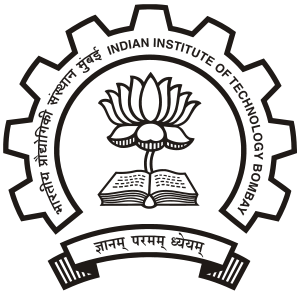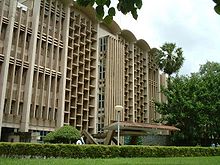IIT Bombay was the second IIT to be established in 1958 with assistance from UNESCO and with funds contributed by the Soviet Union. UNESCO agreed to provide equipment and technical experts mainly from the Soviet Union, while the Government of India accepted the responsibility for all other expenses including the cost of the building project and recurring expenses. The site chosen for the institute was Powai, eighteen miles (29 km) from the city of Mumbai (then Bombay), with an area of 550 acres (2.2 km2) which was given by the then Bombay State Government. While construction was being completed, the first academic session of the Institute opened on 25 July 1958, in its temporary home at the Synthetic and Art Silk Mills Research Association (SASMIRA) building in Worli, Mumbai with 100 students. These students were selected from over 3,400 applicants for admission to the first year undergraduate engineering programmes of Aerospace, Chemical, Civil, Computer, Electrical, Engineering Physics, Energy, Mechanical, Metallurgical Engineering and MSc Chemistry. One of the main objectives of establishing the Institute was to develop facilities for studies in a variety of specialised engineering and technological sciences. The need for establishing adequate facilities for postgraduate studies and research was kept uppermost in mind in the founding years.
While the Institute was functioning provisionally at Worli, an effort was made to expedite the progress of the building project at its permanent location and Jawaharlal Nehru laid the foundation stone of the Institute at Powai on 10 March 1959.
Campus[edit]

The Tree of Knowledge – a wrought iron sculpture in the lawns facing the Administrative Building at IIT Bombay
The IIT Bombay campus is located at Powai, a suburb in north eastern Mumbai, between the Vihar and Powai lakes. The campus is divided into clusters of buildings. The academic area chiefly comprises the main building, various departmental annexes and auditoria. All department annexes are connected by a corridor named Infinite Corridor. Beyond the Convocation Hall lie most of the hostels. There are a total of 15 hostels, of which two hostels (Hostels 10 and 11) and a part of the newly constructed hostel (Hostel 15) are for female students.
Due to its proximity to the Sanjay Gandhi National Park, the campus is yellow and mostly untouched by the pollution of the rest of the city. The proximity of the campus to the national park has also led to occasional sightings of panthers, Leopards and Gharial (Gavialis gangeticus) crocodiles along the banks of Lake Powai. Sometimes they stray into the campus in chase of hunt.[8]
The institute has two swimming pools; football, hockey and cricket grounds; and tennis, basketball, squash and volleyball courts. It also has a Students’ Activity Center (SAC) for various cultural and other extracurricular activities. In addition to these facilities, the campus also houses two high schools, one of which is a Kendriya Vidyalaya and the other is called IIT Campus School.
-
Sunset at Powai Lake, IIT Bombay
Cultural and non-academic activities
The annual cultural festival Mood Indigo, usually held in the month of December is an event hosted by the student body and the largest of its kind in Asia[citation needed]. The most attractive feature of this 4-day event are the influential personalities who have graced the festival like R D Burman, Aamir Khan, Sir Mark Tully, Sachin Tendulkar, Porcupine Tree, Simple Plan,[11] Mike Portnoy[12] and many more. The organization is known for holding the best cultural competitions, games and musical concerts to draw out the best talent in the country.
Cultural activities like dramatics, Speaking, Literary Arts, Music and Fine Arts also mark an important feature in the life of a student of IIT Bombay. Speaking and Literary Arts have always been very popular in the student community with students actively participating in quizzing, writing and debating activities. IIT Bombay has won the prestigious National Law School Parliamentary Debating Tournament.
The annual Science & Technology festival of IIT Bombay, Techfest,which was started in 1998, is held in the month of January every year and is the largest of its kind in Asia[citation needed]. It comprises various events like competitions, exhibits and talks from guest speakers from around the world. Techfest 2009 was also the first event of its kind in India to conduct its events in other countries.
Apart from cultural and technological activities, the campus is also involved in business activities with bodies like The Entrepreneurship Cell, which support the growth of startups across the globe.
These college festivals are organised, financially managed and conducted entirely by the students of this institute. All these festivals and organisations are sponsored by private enterprise.
Apart from these festivals, various other engineering streams based festivals are also being organised to motivate students towards Science and Technology. These include Radiance (Mechanical Engineering), Zephyr (Aerospace Engineering), AZeotropy (Chemical Engineering), Padarth(Metallurgy and Material Science Engineering), Aagomani (Electrical Engineering) and recently, Aakaar (Civil Engineering).
The institute also has an LGBT alliance club called “Saathi”.[18][19]
Organization[edit]
At the institutional level, IIT Bombay is governed by a Board of Governors with a chairman nominated by the Visitor, the Director as a member and the Registrar as secretary. Besides this, there are four persons having specialised knowledge or practical experience in respect of education, engineering or science nominated by the Council. Two professors are nominated by the Senate. Additionally, one technologist or industrialist of repute is nominated by the Government of each of the States of Maharashtra, Madhya Pradesh and Gujarat.
For all academic matters, the Senate is the authority having control and responsibility for the maintenance of standards of instruction, education and examinations and all other allied academic matters. The Senate is mainly constituted of all the professors of the Institute and the Director is the chairman.
The key people in the execution of the Institute’s activities are the Director and Deputy Director who are assisted by Dean (Research and Development), Dean (Planning), Dean (Students Affairs), Dean (Academic Programmes) and Dean (Resources Development), and the Heads of the Departments, Centres and Schools. The Administration is managed by the Registrar, with senior administrative officers being assigned for specific areas such as Estate Management, Materials Management, Personnel Management, Finance
 and Accounts, and Academic Affairs
and Accounts, and Academic AffairsRankings
University and college Rankings General – International QS (World)[21] 233 QS (Asian)[22] 39 Engineering – India Outlook India[23] 3 Dataquest[24] 1 Government colleges: Mint[25] 1 Internationally, IIT Bombay is ranked overall #233 gobally and No. 39 among Asian institutes in the QS World University Rankings(Quacquarelli Symonds) for 2013.[26][27][28][21] IIT Bombay failed to feature in top 400 in the ranking by the Times Higher Education World University Rankings of 2013-14.[29] It was In India, among engineering colleges, it ranked No. 3 by Outlook India in 2012,[23] and No. 1 by Dataquest in 2011.[24] Amongst government engineering colleges, it was ranked No. 1 by Mint in 2009.[25] The international surveys conducted by Professor Jude Sommerfeld of Georgia Tech, USA since 1964 for every five-year period as well as every year and also during the 5-year period during 2004–2009 which included all IITs and IISc. IIT Bombay is always ranked among the topmost in this survey
Departments, centres, and schools
IIT Bombay has 17 departments, 13 multi-disciplinary centres, and 3 schools of excellence. The academic departments in IIT Bombay include the following:
- Aerospace Engineering
- Applied Mechanics
- Biosciences and Bioengineering
- Chemical Engineering
- Chemistry
- Civil Engineering
- Computer Science & Engineering
- Earth Sciences
- Electrical Engineering
- Energy Science and Engineering
- Urban Studies and Planning
- Humanities & Social Science
- Industrial Design Centre
- Mathematics
- Mechanical Engineering
- Metallurgical Engineering and Materials Science including Corrosion Science and Engineering
- Physics
The following multi-disciplinary centres are located in IIT Bombay:
- Industrial Design Center (IDC)
- Computer Aided Design Center (CAD)
- Centre for Research in Nano-Technology and Sciences (CRNTS)
- Centre for Aerospace Systems Design and Engineering (CASDE)
- Computer Centre
- Centre for Distant Engineering Education Programme (C-DEEP)
- Centre for Environmental Science and Engineering (CESE)
- Centre of Studies in Resources Engineering (CSRE). Established 1976, the center is involved in developing Remote Sensing technology and its application to natural resources management and Environmental monitoring.
- Centre for Technology Alternatives for Rural Areas (CTARA)
- Centre for Formal Design and Verification of Software (CFDVS)
- Sophisticated Analytical Instrument Facility (SAIF)
- Centre of Excellence in Nanoelectronics (CEN)
- National Centre for Photovoltaic Research and Education (NCPRE)
- Society for Innovation and Entrepreneurship [20](SINE)
The three schools of excellence in IIT Bombay are:
- School of Biosciences and Bioengineering (Bioschool)
- Shailesh J Mehta School of Management (SJMSOM)
- Kanwal Rekhi School of Information Technology (KReSIT)
In addition to above, IIT Bombay also offers three inter-disciplinary programs:
- Educational Technology
- Industrial Engineering and Operations Research (IEOR)
- Systems and Control Engineering
Contact Us
Mailing Address
Address: IIT Bombay, Powai, Mumbai 400 076, Maharashtra, India
Phone: +91 (22) 2572 2545
Fax: +91 (22) 2572 3480Working Hours
9:15 am to 5:45 pm (Monday to Friday) WEB http://www.iitb.ac.in/en





